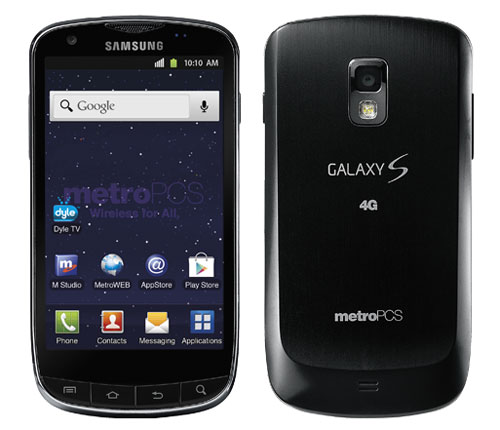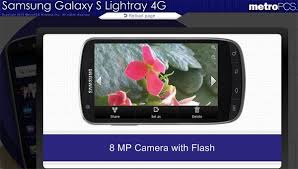Smartphones offered by prepaid carriers tend to be bottom-of-the-barrel handsets the big cellular companies won't touch or old devices they're trying to offload in bulk. That's why it's refreshing to see the Samsung Galaxy S Lightray 4G for Metro PCS. While this $459 phone has a frighteningly high sticker price and borrowed plastic design, it breaks new ground with its live digital TV service and 4G LTE connection. Of course, unless you're absolutely in love with your local TV programming, you should probably pass this gadget by.
Design

The Samsung Galaxy S Lightray 4G certainly boasts a futuristic name, but don't be fooled. Just like its close cousin on U.S. Cellular, the Galaxy S Aviator isn't a flagship smartphone even though it seems that Metro PCS really wishes it was.
In reality the Lightray 4G is a midrange smartphone that falls somewhere between the original Galaxy S and its more robust Galaxy S II sequel. Not even the phone's design is new; it's a dead ringer for the Galaxy S Aviator and older Droid Charge.
As a result, I knew I wouldn't be blown away by the Lightray 4G's all-plastic construction. That said, I do appreciate the phone's sturdy build quality, attractive curves, and beveled edges that wrap tightly around its 4.3-inch screen.

Samsung equipped the Galaxy S Lightray 4G with a decent if low-res Super AMOLED (800x400-pixel) display, too. It manages to paint a pretty picture with vibrant colors, deep blacks, and wide viewing angles. In fact the display held its own when stacked up against the higher-resolution HD Super AMOLED (1,280x720-pixel) screen on the Samsung Galaxy Nexus. Details on the Lightray 4G though weren't as crisp, which is understandable given the Galaxy Nexus' greater pixel density.


Measuring 5.1 inches tall by 2.7 inches wide by 0.46 inch thick, the phone's black slab shape isn't trim by any means. It's actually thicker and wider than the clunky Huawei Activa 4G (4.8 inches tall by 2.4 inches wide by 0.4 inch thick). Still, the Galaxy S Lightray 4G's extra girth feels comforting when gripped, especially for larger hands like mine. A power key placed on the right side is within easy reach, as is a volume bar on the left. Completing the phone's connections are a standard 3.5mm headphone jack and an HDMI port to connect to HDTVs and monitors.
Above the screen is a 1.3-megapixel front-facing camera, which is higher-resolution than the VGA vanity cam found on the Huawei Ativa 4G but lower than the forward-looking sensor on the Galaxy S II (2 megapixels). On back is the Lightray's main 8-megapixel sensor and LED flash which matches the sensitivity of the Galaxy S II's primary imaging system.
I like the feel of the Galaxy S Lightray 4G's back battery cover, which is coated in a matte-black finish and does a good job of repelling fingerprints. Removing the thin cover reveals a 16GB microSD card and LTE SIM card you can access without fiddling with the phone's 1,600mAh battery.
What separates the Lightray 4G from other smartphones, however, is a telescoping antenna tucked into the handset's top right edge. Looking like a throwback to the 20th century, the thin aerial unfurls to grab hold of digital broadcasts from terrestrial TV stations enabling the Dyle live video service.
Features
Running Android 2.3 Gingerbread, the Samsung Galaxy S Lightray 4G offers a basic Android experience. There are seven home screens to choose from that you can fill with your favorite widgets and application shortcuts. Right out of the box, the phone comes with icons to launch apps for the Dyle TV service, Rhapsody Music, and M Studio ringtone and music store. Shortcuts for the Metro PCS app store and Google Play Store plus the carrier's custom Web browser are placed front and center too.
Running Android 2.3 Gingerbread, the Samsung Galaxy S Lightray 4G offers a basic Android experience. There are seven home screens to choose from that you can fill with your favorite widgets and application shortcuts. Right out of the box, the phone comes with icons to launch apps for the Dyle TV service, Rhapsody Music, and M Studio ringtone and music store. Shortcuts for the Metro PCS app store and Google Play Store plus the carrier's custom Web browser are placed front and center too.
Additionally, Google's staple services are onboard with Gmail, Navigation, Talk, Play Books, and YouTube software preloaded. Basic music and video players are located in the Android app tray as well.
Like other Galaxy handsets, Samsung also overlays its TouchWiz interface on top of stock Android. Aside from its fancy weather app powered by AccuWeather, I couldn't find other flashier TouchWiz functions usually installed on other Galaxy phones such as the Samsung Galaxy S II. These include Live Panel Widgets, which increase functionality depending on their size, or zooming in and out of images and documents by tilting the phone while touching the screen with both thumbs.
Dyle TV

The Samsung Galaxy S Lightray 4G's stand-out feature is the phone's Dyle TV functionality. The first handset to connect to this service, Dyle allows you to watch live television broadcast from local TV stations. Just tap the open app, extend the telescopic antenna, and select your location from a drop-down list.
The Samsung Galaxy S Lightray 4G's stand-out feature is the phone's Dyle TV functionality. The first handset to connect to this service, Dyle allows you to watch live television broadcast from local TV stations. Just tap the open app, extend the telescopic antenna, and select your location from a drop-down list.
You'll then see a rundown of all available channels and which ones are currently within range. Don't get our hopes up though, there are only four stations to choose from at least in New York. These channels are FOX, NBC, qubo children's programming, and Telemundo Spanish-language programing. A free and open digital TV receiver the Lightray 4G is not, especially considering the phone's HDMI port blocks Dyle video output to compatible TV sets.
The good news, though, is that Dyle is free, you can skip the ads, and it won't take a bite out of your data bucket. Also, when the Lightray 4G was able to lock on to a signal, video played smoothly without stuttering. I could even nab reception inside my office building, which is a lot more than I can say for many cellular connections. Be advised; video quality for Dyle is limited to standard definition.
Camera

As with the Samsung Galaxy S Aviator, the 8-megapixel camera is one of the Samsung Galaxy S Lightray 4G's strengths. Indoor test shots were clear with sharp details and accurate color even under fluorescent lighting. Outside, the Lightray had no trouble snapping colorful shots in moderate morning sunlight. The green leaves, and red and purple flowers were bright, and shadow details weren't lost since images were properly exposed.

As with the Samsung Galaxy S Aviator, the 8-megapixel camera is one of the Samsung Galaxy S Lightray 4G's strengths. Indoor test shots were clear with sharp details and accurate color even under fluorescent lighting. Outside, the Lightray had no trouble snapping colorful shots in moderate morning sunlight. The green leaves, and red and purple flowers were bright, and shadow details weren't lost since images were properly exposed.

With a maximum resolution of 720p, video I captured with the Galaxy S Lightray 4G wasn't bad either, though details came through on the soft side and weren't as sharp as from phones capable of full 1080p HD quality.
Performance

Powered by an aging single-core 1GHz Samsung Hummingbird processor complemented by 1.37GHz of internal memory, don't count on the Samsung Galaxy S Lightray 4G to win any performance awards. The phone felt sluggish merely flipping through the home screens and opening apps.

Powered by an aging single-core 1GHz Samsung Hummingbird processor complemented by 1.37GHz of internal memory, don't count on the Samsung Galaxy S Lightray 4G to win any performance awards. The phone felt sluggish merely flipping through the home screens and opening apps.
Backing up what I experienced, the handset turned in a low Linpack benchmark score of 17.3 MFLOPs completed in 4.84 seconds. That said, this result was slightly higher than the Galaxy S Aviator, which managed 16.2 MFLOPS finished in a longer 5.17 seconds. By contrast, the HTC One S (T-Mobile) with its dual-core Snapdragon S4 chip powered through the same task in 0.82 second and notched a high score of 102.4 MFLOPS (single core).
Processing speed isn't the only bar by which to measure a smartphone, though. As one of Metro PCS's latest handsets to connect to the carrier's 4G LTE network, the Galaxy S Lightray 4G can suck down data at a swift clip. In New York I measured average download throughput at 6.4Mbps; uploads clocked in at a respectable 4Mbps.
Call quality on the Metro PCS CMDA network in New York was more of mixed bag, though. Calls I placed were clear and static-free on my end but callers reported that my voice had a compressed, cell-phone sound along with some background hiss. As with the Aviator, the Lightray's earpiece doesn't get very loud nor does its speakerphone.
SPECS
HARDWARE
| Height | 5.11 inches |
|---|---|
| Width | 2.66 inches |
| Thickness | .46 inches |
| Weight | .3 pounds |
| Form factor | Slab |
| Primary orientation | Portrait |
| Color | Black |
DISPLAY
| Screen size (diagonal) | 4.3 inches |
|---|---|
| Technology | Super AMOLED Plus |
| Pixel arrangement | RGBG (PenTile) |
| Touchscreen type | Capacitive |
CONNECTIVITY
| Carriers | MetroPCS |
|---|---|
| 3G Connectivity | Yes |
| 4G Connectivity | Yes |
| LTE | Yes |
| Wi-Fi | Yes |
| Bluetooth | Yes |
| Tethering / mobile hotspot | Yes |
PROCESSOR
| Clock speed | 1 GHz |
|---|
STORAGE
| External | Yes |
|---|---|
| Max external size | 32 GB |
| External type | Unspecified |
FRONT CAMERA
| Resolution | 1.3 megapixels |
|---|
REAR CAMERA
| Resolution | 8 megapixels |
|---|---|
| Flash | LED |
SOFTWARE
| Operating system | Android |
|---|---|
| Launch OS version | Android 2.3.3 |
Conclusion
In my view it's wise to be wary of products with first-gen services or hardware. The $459 Samsung Galaxy S Lightray 4G is great example of this. Those expecting the handset to operate as a true portable TV set picking up all the free digital TV stations in range will be sorely disappointed. With only four channels to choose from and a locked-down HDMI port, the Lightray won't replace your cable box anytime soon. Also, the phone runs an outdated Android operating system that's powered by a weak single-core processor. Sure, the Lightray 4G has a decent camera, LTE data, and colorful screen, but if you're on Metro PCS, then choosing the more affordable $199 Samsung Galaxy Attain 4G would be a better decision.
